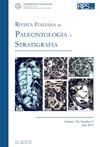RECONSTRUCTING KUNGURIAN (CISURALIAN, PERMIAN) TERRESTRIAL ENVIRONMENTS WITHIN A MEGACALDERA IN THE SOUTHERN ALPS (N-ITALY) USING LITHOFACIES ANALYSIS, PALYNOLOGY AND STABLE CARBON ISOTOPES
IF 1.9
3区 地球科学
Q2 GEOLOGY
引用次数: 2
Abstract
During the Permian, climate experienced a change from icehouse to greenhouse conditions. Few multidisciplinary studies have investigated Kungurian (late Cisuralian) tropical terrestrial ecosystem and climate changes. Here, we apply an interdisciplinary approach to two alluvial-lacustrine successions of the Athesian Volcanic Group (Southern Alps, northern Italy) deposited in a Kungurian megacaldera during periods of volcanic quiescence. Sedimentological analysis combined with palynofacies studies allowed the reconstruction of the depositional environments. The study of sporomorph assemblages and stable organic carbon isotopes provided information on plant communities and the climate context. Two different depositional environments were present in the megacaldera: one proximal and one more distal with respect to the source, distinguished by a slightly different composition of the sediments, palynofacies and organic carbon isotopes. The plant community in the area was dominated by xeromorphic-hygromorphic taxa. The δ13Corgvalues are comparable to those of other Cisuralian continental organic matter and plants. The stable carbon isotope values show a small variability, which correlates weakly, but significantly, with the abundance of xeromorphic elements. All observations support deposition during semiarid to arid climate conditions, typical of the mid-late Cisuralian in the area.利用岩相分析、孢粉学和稳定碳同位素重建了南阿尔卑斯(n -意大利)一个巨型火山口内的昆古里亚(顺苏拉、二叠纪)陆地环境
在二叠纪,气候经历了从冰库到温室的变化。很少有多学科的研究对昆古里期(晚西乌拉尔期)热带陆地生态系统和气候变化进行调查。在这里,我们将一种跨学科的方法应用于火山静止期沉积在昆古里大破火山口的阿萨西亚火山群(意大利北部阿尔卑斯山南部)的两个冲积湖序列。沉积学分析与孢粉相研究相结合,可以重建沉积环境。孢子形态组合和稳定有机碳同位素的研究为植物群落和气候背景提供了信息。大破火山口存在两种不同的沉积环境:一种是近源沉积环境,另一种是远端沉积环境,其特征是沉积物成分、孢粉相和有机碳同位素略有不同。该地区的植物群落以旱湿性类群为主。δ13Org值可与其他西苏拉尔大陆有机质和植物的值相比较。稳定的碳同位素值显示出较小的可变性,与干晶元素的丰度相关性较弱,但显著。所有观测结果都支持在半干旱到干旱的气候条件下沉积,这是该地区典型的中晚期喜苏拉尔期。
本文章由计算机程序翻译,如有差异,请以英文原文为准。
求助全文
约1分钟内获得全文
求助全文
来源期刊
CiteScore
3.60
自引率
4.30%
发文量
28
审稿时长
>12 weeks
期刊介绍:
The Rivista Italiana di Paleontologia e Stratigrafia was founded in 1895. It publishes original papers dealing with all fields of paleontology and of stratigraphy, from Italy and the Mediterranean to the Tethys, as well across the globe from China to North America.

 求助内容:
求助内容: 应助结果提醒方式:
应助结果提醒方式:


